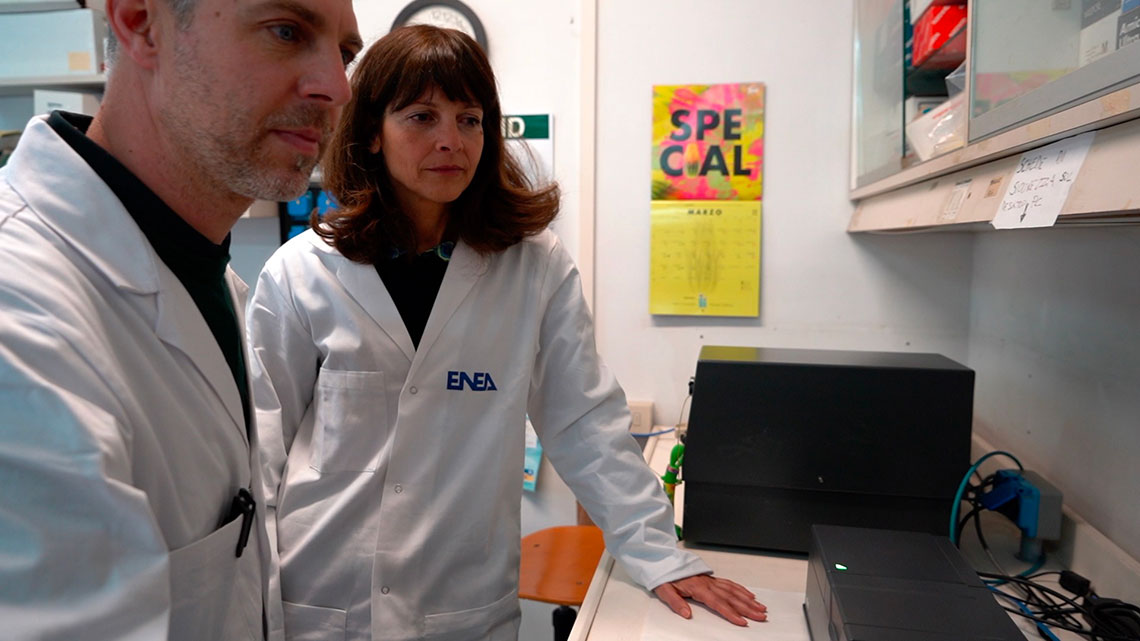Italian National Agency for New Technologies, Energy and Sustainable Economic Development

Food: ENEA creates test kit to detect toxins in milk
ENEA has developed a diagnostic kit for dairy companies and analysis laboratories capable to detect traces of aflatoxin M1[1] (a known carcinogenic which comes from animals fed with contaminated feed) in raw milk, rapidly, effectively and cheaply. The findings of a study conducted jointly with the University of Turin were published in the scientific journal Toxins. Due to the toxicity of aflatoxins to humans and animals, the EU set maximum tolerable limits of aflatoxin M1 to 50 nanograms/liter (50 ppt) in raw milk, heat-treated milk and milk intended for cheese production. And it has further lowered this threshold value in foods intended for infants and children (25 ng/l), who are among the major consumers of milk.
The analysis technique developed at ENEA uses monoclonal antibodies[2] produced by a plant of the same genus as tobacco (Nicotiana benthamiana), to detect toxins in milk even at low concentrations - well below the limits set by law - as shown by the experiments conducted on raw milk samples containing different concentrations of aflatoxin M1 (25, 50 and 75 nanograms/L). “A 'green' version of ELISA[3], one of the best and most commonly used rapid screening methods to detect toxins in food and animal feed, which allows an accurate, rapid and low-cost analysis of a significant number of samples”, explained Marcello Catellani at the ENEA Bioproducts and Bioprocesses Laboratory.
Researchers produced antibodies by Plant Molecular Farming (PMF), a system that uses plants to produce complex molecules like antibodies. “It’s a biotechnological approach which has the advantages of being more affordable than traditional systems based on animal cell cultures which require dedicated structures and sterile environments, specific reagents and tools, like bioreactors and incubators”, said Catellani.
The PMF enables work in non-sterile conditions (greenhouse, water, light, soil) at minimum cost. This time it was used the agroinfiltration technique which involves the injection of a particular bacterium called Agrobacterium tumefaciens which carries the genetic information of interest in the plant tissues of the Nicotiana benthamiana plant. “This process is advantageous in terms of speed and yield: the agrobacteria, which have the task of conveying the genetic information in the plant, take only 1-2 days to grow and after about a week it is possible to collect the leaves from which to extract up to 1.6 g/kg of antibodies. Therefore, the scale-up of this production is immediate, easily modulated and inexpensive, if compared with in vitro cell cultures, because it simply requires an expansion of cultivation space ", pointed out Cristina Capodicasa at the ENEA Biotechnology Laboratory.
Aflatoxins are mycotoxins produced by fungi belonging to the genus of Aspergilli which usually develop in foodstuffs stored at temperatures between 25 and 32°C and at a relative humidity over 80 percent. They cannot be seen with the naked eye, are tasteless and, above all, show high thermal stability during heat treatments like milk pasteurization.

Notes
[1] M stands for milk, where aflatoxin was detected for the first time. It’s a metabolite which derives from aflatoxin B1. B refers to blue, because aflatoxins exhibit a blue fluorescence under UV radiation
[2] Monoclonal antibodies (mAbs) are complex proteins generated by the animal immune system, isolated and produced in the laboratory for their ability to specifically bind a target of interest. They are identical antibodies, produced by cell lines derived from a single type of immune cell, i.e. a cell clone.
[3] The ELISA method (Enzyme-Linked Immunosorbent Assay or enzyme-linked immunosorbent assay) detects and identifies (both qualitatively and quantitatively) in a substance sample. In this type of analytical assay, the substance to be measured (analyte) the substance to be measured (called an analyte) is recognized and bound by another (generally an antibody) which detects its presence.
